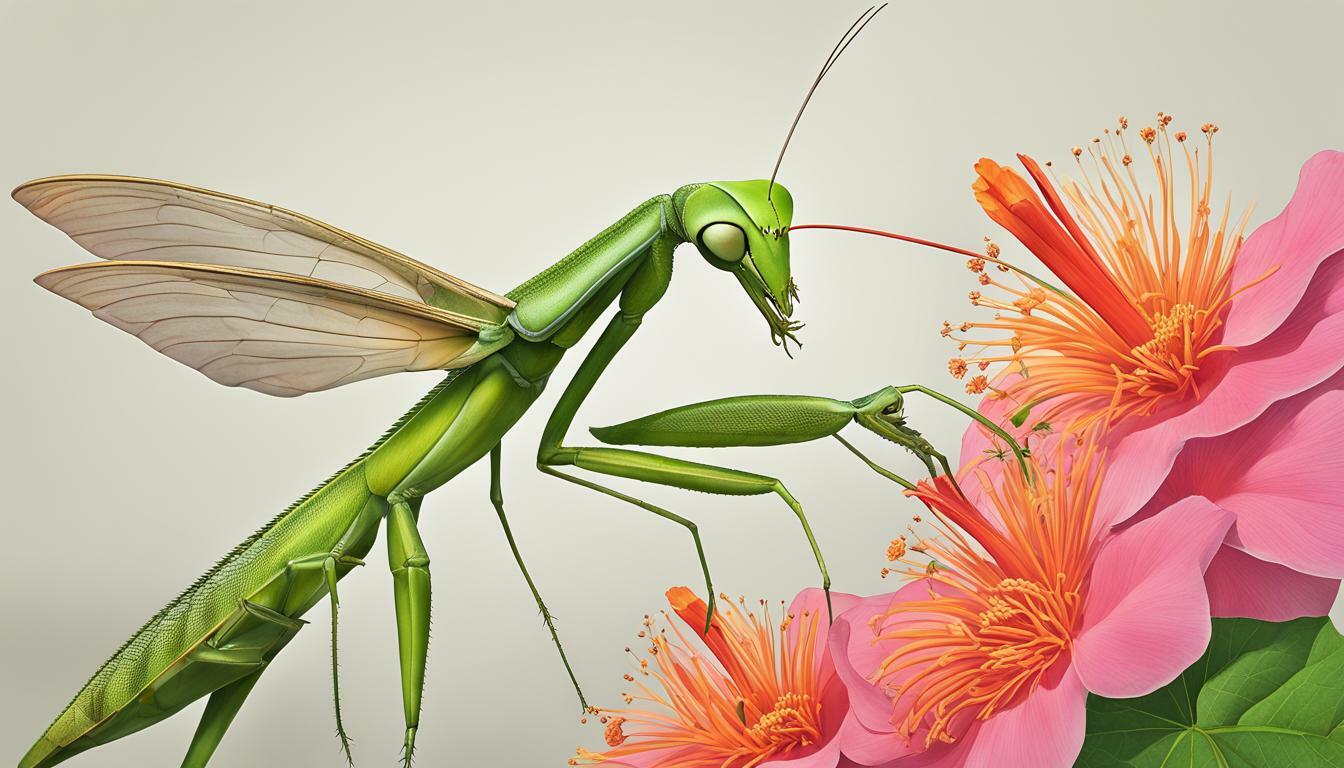Praying mantises and hummingbirds are fascinating creatures, and the possibility of these two animals interacting raises some intriguing questions. One of the most common queries is whether praying mantises eat hummingbirds. In this section, we will delve into the dietary habits of praying mantises, their behavior, and their interactions with hummingbirds to provide you with a comprehensive guide on the topic.
Key Takeaways
- Praying mantises may prey on hummingbirds, but it is unlikely due to differences in size and strength.
- Praying mantises typically feed on insects, spiders, and other small animals.
- Hummingbirds serve as prey to other natural predators such as birds of prey, snakes, and lizards.
- Observations and studies have shown some instances of praying mantises consuming hummingbirds, but these situations are rare.
Hummingbird Facts and Behavior
When it comes to these tiny, colorful birds, there’s much more to them than meets the eye. Did you know that there are over 300 species of hummingbirds, all native to the Americas? They range in size from the tiny bee hummingbird, which is only 2.4 inches long, to the slightly larger and more common ruby-throated hummingbird, which can grow up to 3.5 inches in length.
Hummingbirds are known for their unique flying ability – they can hover in place, fly forwards, backwards, and even upside down. They’re also known for their vibrant colors, which serve as a signal to potential mates and rivals. But hummingbirds aren’t just fascinating to observe, they also play a crucial role in their ecosystem as pollinators and as a food source for a variety of predators, including insects such as praying mantises.
As prey for predators, hummingbirds have developed various defense mechanisms, including their agility and speed, which can reach up to 30 miles per hour. They also have the ability to make sharp turns in flight, making it harder for predators to catch them. However, despite these defenses, they still fall prey to many predators in the wild.
Praying Mantis Feeding Habits
Praying mantises are carnivorous insects that feed primarily on other insects. Their diet includes crickets, grasshoppers, flies, and other small prey. However, praying mantises are opportunistic feeders and can consume any insect small enough to catch.
Praying mantises are well-known for their hunting techniques, which usually involve sitting still and waiting for prey to come within grabbing distance. When a target is within range, the praying mantis will strike out with its front legs and grasp the prey with its strong spiny forelegs. The insect will then be devoured while still alive.
While praying mantises are primarily insectivores, there have been documented cases of praying mantises capturing and consuming small vertebrates such as lizards, snakes, and even birds. However, such incidents are rare and occur only when the insect is desperate for food or when presented with a unique opportunity.
Factors affecting Praying Mantis Diet
The type of prey consumed by praying mantises depends on several factors, including their habitat, size, and age. For example, praying mantises found in forests are more likely to feed on moths and butterflies, while those found in meadows prefer grasshoppers, crickets, and flies. Larger praying mantises can catch bigger prey, while younger mantises will feed only on smaller insects.
Praying mantises also have a higher chance of capturing slower moving insects that cannot escape their grasp. They are less likely to attack insects that are venomous or have strong defensive mechanisms.
Insect Predation and the Praying Mantis
Praying mantises are formidable predators in the insect world. They have several adaptations that make them successful hunters. For instance, their elongated body and legs give them a wide field of vision and enable them to strike quickly and accurately.
Their ability to consume a variety of insects also ensures that they have a steady food supply. This is important since praying mantises are often preyed upon by birds and large spiders.
Overall, the praying mantis diet is primarily composed of insects, but they have been known to consume small vertebrates when the opportunity arises. Their hunting techniques and ability to adapt their diet to their environment ensure that they remain successful predators in the insect world.
Can Praying Mantises Capture Hummingbirds?
Praying mantises are among the most fascinating insects due to their unique hunting techniques and behaviors. However, their potential to prey on hummingbirds is a highly debated topic, raising questions about the capabilities of these insects. If you’re wondering whether praying mantises can capture hummingbirds, read on to discover the answer.
When it comes to the interaction between hummingbirds and praying mantises, researchers have observed that praying mantises are opportunistic predators, meaning they will capture any prey that comes within their reach. While praying mantises primarily feed on insects, they have been known to consume small vertebrates such as lizards, frogs, and even small birds.
When a hummingbird crosses paths with a praying mantis, the encounter is usually brief. Research suggests that praying mantises rarely target hummingbirds intentionally, and the chances of capturing one are relatively low. Hummingbirds are agile and fast-moving, making it difficult for the praying mantis to catch them.
Moreover, praying mantises typically prefer prey that is smaller than themselves, and hummingbirds are relatively large birds, making them less ideal prey. Praying mantises are also attracted to movement, and hummingbirds are known for their quick and erratic movements, making them less likely targets for these insects.
In summary, although praying mantises have the potential to capture hummingbirds, it is not a common occurrence. Their natural diet consists primarily of insects, and while they might prey on small vertebrates, the chances of capturing a hummingbird are low due to their size, speed, and elusive behavior.
Praying Mantis vs. Hummingbird Size and Strength
Size and strength are important factors in predator-prey relationships. Praying mantises are known to prey on insects, but can they capture and eat a hummingbird?
Hummingbirds are small, agile birds with quick movements. They have the ability to fly backwards and have exceptional speed and maneuverability. Praying mantises, on the other hand, are relatively slow-moving insects with limited mobility.
In terms of size, praying mantises can range from 0.5 to 6 inches in length, depending on the species. Hummingbirds, on the other hand, can range from 2.75 to 8 inches in length, with some species weighing as little as 0.1 ounce.
While praying mantises may be able to capture smaller hummingbirds, larger species would likely be too fast and strong for the mantis to overcome. Additionally, mantises are primarily ambush predators, relying on stealth and surprise to capture their prey. Hummingbirds, with their quick reflexes and flight abilities, may be able to avoid being caught by a mantis.
It’s also worth noting that hummingbirds have other natural predators, including hawks, owls, and snakes. While praying mantises may be capable of capturing and eating hummingbirds, it’s unlikely to be a common occurrence in the wild.
Real-Life Examples and Studies:
While praying mantises are known for preying on a wide variety of insects, the idea of them consuming hummingbirds seems almost impossible. However, there are a few documented cases that suggest otherwise.
In 2014, a wildlife photographer captured a photo of a praying mantis perched on top of a Ruby-throated Hummingbird. While it’s unclear whether the mantis was able to successfully consume the bird, the image sparked a debate about whether this was a common occurrence or a rare incident.
Another case was observed in 2019 when a praying mantis was spotted feeding on a Ruby-throated Hummingbird in the wild. This provided further evidence that praying mantises are capable of capturing and eating hummingbirds. However, it’s important to note that these cases are rare and not a regular part of a praying mantis’ diet.
Scientific studies have also delved into the behavior of praying mantises when it comes to insect predation. One study found that praying mantises use a combination of color, smell, and movement to detect their prey. They also have a remarkable ability to strike at their prey with incredible accuracy and speed.
Additionally, research has shown that praying mantises are opportunistic feeders, meaning they will consume any prey that is within their size range and is not too difficult to catch. While hummingbirds are not a typical part of their diet, it’s clear that they are not completely off-limits as prey.
Conclusion
So, do praying mantises eat hummingbirds? While it’s possible for praying mantises to capture and consume hummingbirds, it’s not a common occurrence. Praying mantises typically prey on insects, and hummingbirds are not their primary food source. Additionally, hummingbirds are fast and agile, making them difficult targets for praying mantises.
However, as with any predator-prey relationship, there are always exceptions. Some documented cases show that praying mantises have been able to capture and eat hummingbirds. These instances are rare and may occur when the hummingbird is weakened or injured.
Overall, it’s important to note that hummingbirds have several natural predators, including larger birds, snakes, and other insects. Praying mantises play a small role in the ecosystem as hummingbird predators, but they are not a significant threat to hummingbird populations.
Can Hummingbirds Eat Praying Mantises?
Hummingbirds and their bug-eating habits make them some of the most fascinating birds in the animal kingdom. While they primarily feed on nectar, they occasionally indulge in insects for essential proteins. However, despite their voracious appetites, praying mantises are usually too large for hummingbirds to consume.
FAQ
Q: Do praying mantises eat hummingbirds?
A: Praying mantises are primarily insectivores and their diet consists mainly of insects. While there have been rare instances of praying mantises capturing and consuming hummingbirds, it is not a common occurrence. Praying mantises typically prey on smaller insects that are easier for them to catch and subdue.
Q: What is the diet of praying mantises?
A: Praying mantises feed on a variety of insects including flies, crickets, grasshoppers, and moths. They are known for their ambush-style hunting technique, where they patiently wait for their prey to come within striking distance before capturing it with their strong front legs.
Q: Are hummingbirds a common prey for praying mantises?
A: No, hummingbirds are not a common prey for praying mantises. Praying mantises are more likely to target smaller insects that are easier for them to capture and consume. However, there have been rare instances where praying mantises have been observed capturing hummingbirds.
Q: Can praying mantises capture and consume hummingbirds?
A: While praying mantises have been observed capturing hummingbirds in some rare cases, it is not their usual prey. Praying mantises are generally not equipped to handle larger and more agile animals like hummingbirds. Their hunting techniques and physical capabilities are more suited for capturing and consuming smaller insects.
Q: Are praying mantises bigger and stronger than hummingbirds?
A: No, praying mantises are generally smaller and less physically powerful compared to hummingbirds. Hummingbirds are agile and fast-moving creatures, while praying mantises rely on camouflage and stealth to capture their prey. The size and strength difference between the two make it unlikely for praying mantises to successfully capture and consume hummingbirds.
Q: Are there any documented cases of praying mantises preying on hummingbirds?
A: While rare, there have been documented cases of praying mantises capturing and consuming hummingbirds. These instances are considered exceptions rather than the norm. Scientific studies and real-life examples provide valuable insights into the behavior and feeding habits of praying mantises, helping us understand the dynamics of these interactions.











